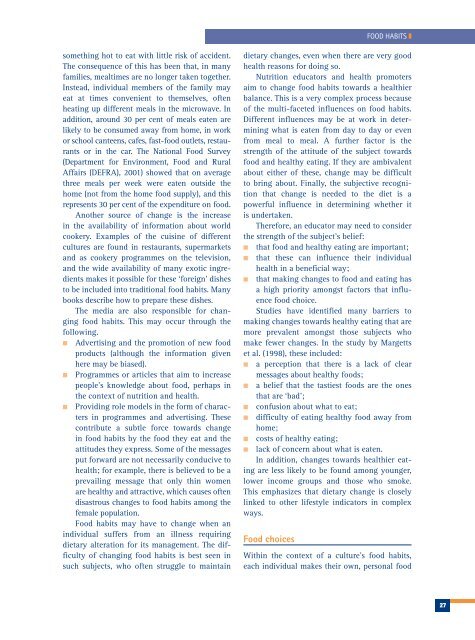Human Nutrition
Human Nutrition
Human Nutrition
You also want an ePaper? Increase the reach of your titles
YUMPU automatically turns print PDFs into web optimized ePapers that Google loves.
FOOD HABITS ❚<br />
something hot to eat with little risk of accident.<br />
The consequence of this has been that, in many<br />
families, mealtimes are no longer taken together.<br />
Instead, individual members of the family may<br />
eat at times convenient to themselves, often<br />
heating up different meals in the microwave. In<br />
addition, around 30 per cent of meals eaten are<br />
likely to be consumed away from home, in work<br />
or school canteens, cafes, fast-food outlets, restaurants<br />
or in the car. The National Food Survey<br />
(Department for Environment, Food and Rural<br />
Affairs (DEFRA), 2001) showed that on average<br />
three meals per week were eaten outside the<br />
home (not from the home food supply), and this<br />
represents 30 per cent of the expenditure on food.<br />
Another source of change is the increase<br />
in the availability of information about world<br />
cookery. Examples of the cuisine of different<br />
cultures are found in restaurants, supermarkets<br />
and as cookery programmes on the television,<br />
and the wide availability of many exotic ingredients<br />
makes it possible for these ‘foreign’ dishes<br />
to be included into traditional food habits. Many<br />
books describe how to prepare these dishes.<br />
The media are also responsible for changing<br />
food habits. This may occur through the<br />
following.<br />
■ Advertising and the promotion of new food<br />
products (although the information given<br />
here may be biased).<br />
■ Programmes or articles that aim to increase<br />
people’s knowledge about food, perhaps in<br />
the context of nutrition and health.<br />
■ Providing role models in the form of characters<br />
in programmes and advertising. These<br />
contribute a subtle force towards change<br />
in food habits by the food they eat and the<br />
attitudes they express. Some of the messages<br />
put forward are not necessarily conducive to<br />
health; for example, there is believed to be a<br />
prevailing message that only thin women<br />
are healthy and attractive, which causes often<br />
disastrous changes to food habits among the<br />
female population.<br />
Food habits may have to change when an<br />
individual suffers from an illness requiring<br />
dietary alteration for its management. The difficulty<br />
of changing food habits is best seen in<br />
such subjects, who often struggle to maintain<br />
dietary changes, even when there are very good<br />
health reasons for doing so.<br />
<strong>Nutrition</strong> educators and health promoters<br />
aim to change food habits towards a healthier<br />
balance. This is a very complex process because<br />
of the multi-faceted influences on food habits.<br />
Different influences may be at work in determining<br />
what is eaten from day to day or even<br />
from meal to meal. A further factor is the<br />
strength of the attitude of the subject towards<br />
food and healthy eating. If they are ambivalent<br />
about either of these, change may be difficult<br />
to bring about. Finally, the subjective recognition<br />
that change is needed to the diet is a<br />
powerful influence in determining whether it<br />
is undertaken.<br />
Therefore, an educator may need to consider<br />
the strength of the subject’s belief:<br />
■ that food and healthy eating are important;<br />
■ that these can influence their individual<br />
health in a beneficial way;<br />
■ that making changes to food and eating has<br />
a high priority amongst factors that influence<br />
food choice.<br />
Studies have identified many barriers to<br />
making changes towards healthy eating that are<br />
more prevalent amongst those subjects who<br />
make fewer changes. In the study by Margetts<br />
et al. (1998), these included:<br />
■ a perception that there is a lack of clear<br />
messages about healthy foods;<br />
■ a belief that the tastiest foods are the ones<br />
that are ‘bad’;<br />
■ confusion about what to eat;<br />
■ difficulty of eating healthy food away from<br />
home;<br />
■ costs of healthy eating;<br />
■ lack of concern about what is eaten.<br />
In addition, changes towards healthier eating<br />
are less likely to be found among younger,<br />
lower income groups and those who smoke.<br />
This emphasizes that dietary change is closely<br />
linked to other lifestyle indicators in complex<br />
ways.<br />
Food choices<br />
Within the context of a culture’s food habits,<br />
each individual makes their own, personal food<br />
27

















